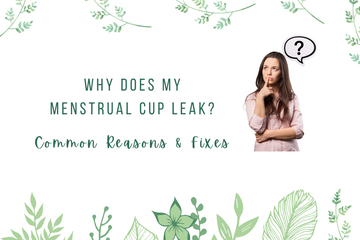Using a menstrual cup can be a game-changer for your period routine—until it starts to leak. If you’ve ever found yourself wondering, “why is my menstrual cup leaking?” you’re not alone. Leaks can be frustrating, but the good news is that they’re usually caused by fixable issues. With a bit of guidance and the right adjustments, you can enjoy a comfortable, leak-free experience every cycle.
In this detailed guide, we’ll explore the most common menstrual cup leaking reasons, how to fix them, and the best menstrual cup leak prevention tips for beginners and seasoned users alike.
1. Improper Seal Formation
One of the most frequent causes of leaks is a poor seal. Menstrual cups rely on suction to stay in place and prevent leaks. If the cup hasn’t fully opened or isn't positioned correctly, the seal won’t form properly. This often happens if the cup is inserted too high, too low, or remains partially folded inside.
To fix this, gently rotate the cup or run a clean finger around its base to ensure it has fully expanded. Inserting the cup at a slight angle toward your tailbone also helps position it correctly. This solves most basic menstrual cup seal problems.
2. Wrong Cup Size
Choosing the wrong cup size can lead to leaks. If your cup is too small, it may not reach the vaginal walls firmly enough to create a good seal. If it’s too large, it might not open properly or could feel uncomfortable.
Use a sizing guide based on age, cervix height, and flow. For high cervixes, longer cups work better. For low cervixes, shorter ones are more comfortable and secure. Getting the right fit is crucial for both comfort and leak prevention.
Finding the right fit can make a world of difference. Our detailed menstrual cup size guide helps you choose the perfect size based on your cervix height, flow, and more.
3. High or Low Cervix Position
If your cup sits too far from your cervix or too close to it, leaks may happen. Understanding your cervix height is key to choosing and positioning your cup properly. If the cup doesn’t sit directly beneath the cervix, blood can bypass the cup and leak out.
Check your cervix during your period by inserting a clean finger. If it’s easy to touch, it’s low. If you struggle to reach it, it’s high. Use this info to position your cup correctly or switch to a cup designed for your anatomy.
4. Overflow Due to Heavy Flow
Sometimes your cup leaks simply because it’s full. If you have a heavy flow, the cup may reach its capacity before the 12-hour mark. This is a common reason for leaking, especially on heavy days.
In such cases, use the best menstrual cup for heavy flow, which offers higher capacity. Empty your cup more frequently during the first few days of your period. This prevents overflow and gives you better leak control.
5. Residual Blood During Insertion
After you insert your cup, you might notice immediate spotting or leakage. This isn’t necessarily a leak from the cup itself—it could be residual blood left in the vaginal canal during insertion.
Wipe the vaginal opening with toilet paper or rinse the area after inserting the cup to remove leftover blood. This step helps differentiate real leaks from harmless spotting.
6. Weak Pelvic Floor Muscles
If your pelvic floor muscles are weak, they may not hold the cup in place properly, which affects the seal. Pregnancy, childbirth, or age can all impact muscle tone. As a result, the cup might shift or move, causing leaks.
Strengthening your pelvic muscles through Kegel exercises can improve this issue. In some cases, using a firmer or wider cup helps the cup stay in place more securely.
7. Inserting the Cup Incorrectly
Rushing through insertion can result in folds or poor placement. This prevents the cup from fully opening and forming a seal. Even experienced users sometimes insert the cup at the wrong angle.
Follow a menstrual cup insertion guide closely and don’t skip the step of checking if the cup has fully opened. Practicing different folds like the C-fold, punch-down, or 7-fold can also make a big difference.
If you’re unsure about getting your cup to open properly during insertion, check out our step-by-step menstrual cup insertion guide with detailed illustrations to make the process easier and more comfortable.
8. Not Breaking the Seal During Removal
If you’re removing your cup without breaking the seal, it can shift or move out of place over time. This may cause future leaks if not reinserted properly afterward.
Always pinch the base of the cup or slide a finger alongside to release the suction before removing it. Reinserting it properly ensures continued leak protection.
9. Wearing the Cup Too Long
Although most menstrual cups can be worn up to 12 hours, this depends on your flow. Wearing a cup for too long increases the chance of leaks, especially for people with a heavy flow.
Track your cycle for a few months to learn when your heaviest days occur. On those days, empty the cup more frequently—every 4 to 6 hours—to avoid leaks from overfilling.
10. Not Cleaning the Rim Properly
Sometimes, tiny bits of dried blood or debris can prevent the cup from sealing correctly. If the rim of the cup isn’t clean, it won’t sit flush against the vaginal walls.
Make sure you thoroughly clean your cup after each use, especially the rim and air holes. These parts help maintain suction and need to be free of any blockages.
Conclusion
If you’ve been struggling with leaks, understanding these menstrual cup leaking reasons is the first step toward a better period experience. From improper sealing and size issues to anatomy-related challenges, most causes are simple to fix. With the right menstrual cup removal tips, insertion techniques, and sizing knowledge, leaks can be a thing of the past. Follow these menstrual cup leak prevention tips and enjoy the full benefits of this eco-friendly, cost-effective period solution.
Still deciding if a menstrual cup is right for you? Compare it with tampons and pads in our detailed guide on menstrual hygiene options to find the best fit for your lifestyle.
FAQs
1. Why does my menstrual cup leak even when it's not full?
Leaks often happen due to a poor seal, incorrect placement, or size mismatch rather than overflow. Ensure the cup has fully opened and is sitting under the cervix to catch all menstrual fluid effectively.
2. Can a tilted uterus cause menstrual cup leaks?
Yes. A tilted uterus can change how the cup fits. If your cervix points differently, your cup may not sit directly beneath it. Using a softer or angled cup might provide a better fit for your anatomy.
3. How do I stop my menstrual cup from leaking overnight?
Use a high-capacity cup designed for overnight wear and ensure it’s inserted properly before bed. Empty it right before sleep and choose a cup that forms a firm seal to prevent movement during the night.
4. Should the cup be placed directly under the cervix?
Yes. For best results, the cup should sit just below your cervix. If it’s off-center, fluid can bypass the cup and cause leaks. You can locate your cervix with a clean finger to guide placement.
5. Is it normal to leak while learning how to use a menstrual cup?
Yes. Many users experience leaks in the beginning as they adjust to the learning curve. Practice with different folds, angles, and cup positions. With time, it becomes easier to create a proper seal.
6. Can cup size alone fix my leaking issue?
No. While size matters, sealing, insertion technique, and cervix height are also critical. A perfectly sized cup can still leak if not inserted properly or if the seal isn’t formed. Combine size with correct usage for best results.
7. Are softer cups more likely to leak?
Yes. Softer cups may collapse more easily and struggle to open fully inside the vagina, which affects sealing. They’re great for comfort but may require more careful placement. If leaking persists, try a firmer model.






